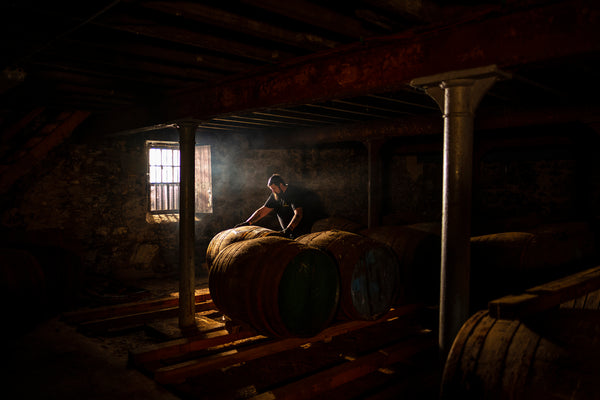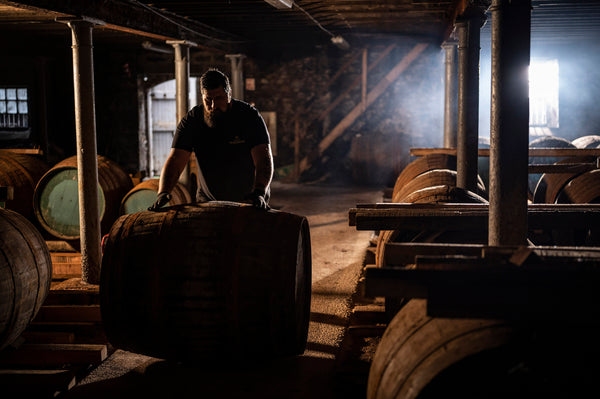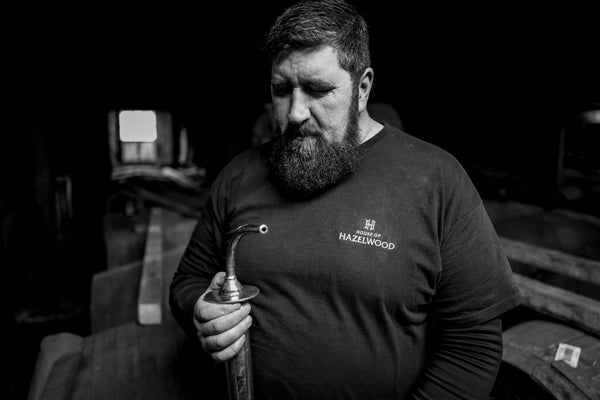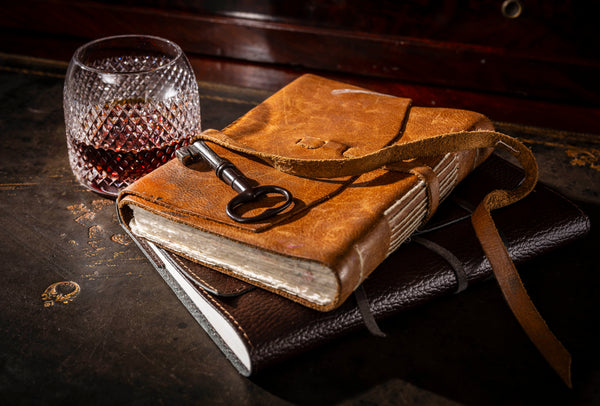The Warehouseman: the guardian charged with the care and monitoring of whisky as it slumbers, this whisky maker is privy to some of the rarest drops in the world.
Perhaps one of the most sought-after roles in the world, a Warehouseman is a pillar of trust in a professional that has historically been synonymous with the dipping and syphoning of spirit through the employment of a copper dog or valinch.
One such upstanding professional is George Paterson, a Warehouseman, and the sampling lead for the House of Hazelwood. Born in Aberdeen, but raised in Elgin, you could consider George a Speysider through and through. For over a decade, George has tended to and cared for our extensive stocks, working alongside industry veterans such as Dennis McBain the coppersmith. With great responsibility comes great reward – something of which, George is generous enough to share with us.

When did you first begin in your role as a caretaker of the House of Hazelwood Inventory?
It would have been 13 years ago; I began in 2009. I originally came into the role as a temp in the warehouse team and worked my way up the ranks quite quickly from there.
Do you come from a family that has worked in the industry?
No, I’m the first to work in the whisky industry. Before I worked in whisky, I used to work for my father’s roofing business. After working there for a while, I decided I’d had enough and went backpacking on a tour around the world. When I came back, I did the odd labouring job while trying to work out what I wanted to do as a career. I popped my name in to work in the warehousing team and one day I got a call on the Friday saying I was starting on the Monday and that was it – I’ve never looked back.
I never expected to be here – I always thought I’d settle somewhere else having travelled the world. I never thought I’d settle back “hame”!
What is your day-to-day job?
My day-to-day job is basically monitoring and drawing samples on behalf of the whisky stocks and blending team. I’ll get a request from a blender looking for a selection of samples, and I source these within the warehouses. I also operate in quality control – I monitor how casks are developing over time – how they are getting on with secondary finishes and the like. I always look forward to the “special” ones.
Sensory wise, I love to nose. I love the aromas – even just going into the warehouse, the smell never gets old when it hits you. I’ve been doing it for years and every time I walk into a warehouse, I think it is magic – all that oak and whisky.
What does sampling entail?
There’s more to it than just collecting requests. Purely out of my own fascination and intrigue, I nose every sample myself just to see if there’s something different. If there’s something I really like, I’ll flag it up to the malt masters and if there’s something that is developing in an unexpected way I’ll also raise that so we can take action.

Is there formal training with this type of sampling?
This sort of sensory processing and assessment is self-taught. I’ve learned it on the job by doing it day by day. It’s quite a repetitive job, so when you discover new things, it mixes it up.
How many casks do you sample in a week?
I can sample between 20 to 50, it varies depending on the week and the requests. To properly assess that volume of samples, it easily takes a few days. It is quite a slow process to actually do the sampling – drawing the sample is the quickest bit! There’s all the prep beforehand, locating in the system where the casks are, processing the sample, logging it into the system, filing duty paid, etc. It’s all the admin that takes up the time. The fun part is the sampling itself.
Can you recall off the top of your head where an exceptional cask is in the warehouses?
We sample aged and rare stock every year for quality monitoring purposes – once you’ve done those, you get to know those spots well! You also always remember those with a “wow” factor too. I believe the best liquids are in the old dunnage warehouses – there’s so much wood and oak and it’s a bit warmer than racked warehouses – I do think that has an impact.
When I host whisky tastings in the warehouse, those exceptional casks are always at the back of my mind. If you’re lucky enough, you might get to try a drop from the cask.

What are the tools of the trade?
I use a hammer and a spike to extract the bung from the cask. I also have a copper Valinch that Dennis McBain kindly made for me. And of course, the sample bottles to decant into.
When did you officially take on the mantle of guardianship of the casks at House of Hazelwood?
I’d already sampled the whiskies within the range, before I knew it was destined to be for the House of Hazelwood. There has always been a great mystique around these casks. In 2022, I started to receive requests for casks that I’d never sampled before – but I knew we had them as I’d walked past them every day. Every sample was amazing - each one is so unique and different from the last. You didn’t know what you were going to be getting.
Did you know these were the Gordon family casks?
I was aware that some of the casks were the private stocks of the family, but when it came to sampling the range and new releases, I didn’t realise that there was just so much in the inventory.




